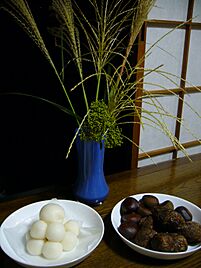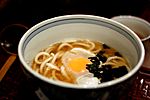Tsukimi facts for kids
Quick facts for kids Tsukimi |
|
|---|---|

Offerings for the September 13 Moon: Tsukimi dango (left), susuki grass (middle) and chestnuts (right)
|
|
| Official name | Tsukimi (月見) |
| Observed by | Japanese |
| Type | Cultural, religious (Buddhist) |
| Significance | Celebrates the harvest |
| Observances | Burn incense at temples and consume dango |
| Begins | 15th day of the 8th lunar month |
| Ends | 18th day of the 8th lunar month |
| Date | 13th day of the 9th lunar month |
| 2024 date | Error in {{Calendar date}} - Check |holiday= unknown holiday Tsukimi |
| 2025 date | Error in {{Calendar date}} - Check |holiday= unknown holiday Tsukimi |
| 2026 date | Error in {{Calendar date}} - Check |holiday= unknown holiday Tsukimi |
| 2027 date | Error in {{Calendar date}} - Check |holiday= unknown holiday Tsukimi |
| Frequency | Annual |
| Related to | Mid-Autumn Festival (in China) Chuseok (in Korea) Tết Trung Thu (in Vietnam) Uposatha of Ashvini/Krittika (similar festivals that generally occur on the same day in Cambodia, Sri Lanka, Myanmar, Laos, and Thailand) |
Tsukimi (月見) or Otsukimi (お月見) means "moon-viewing." These are Japanese festivals that celebrate the autumn moon. They are a type of Mid-Autumn Festival.
The main celebration for the full moon usually happens on the 15th day of the eighth month in the old Japanese calendar. This night is called Jūgoya (十五夜), or "fifteenth night." People also celebrate the waxing moon on the 13th day of the ninth month. This is known as Jūsan'ya (十三夜), or "thirteenth night." These special days usually fall in September and October in our modern calendar.
The tradition of Tsukimi started a long time ago, during the Heian era. It is still very popular in Japan today. Some people even repeat the moon-viewing activities for several nights after the full moon appears.
During Tsukimi, people put up decorations made from Japanese pampas grass (called susuki). They also eat special rice dumplings called Tsukimi dango. These traditions help them celebrate the moon's beauty. People also display seasonal foods as gifts for the Moon. For the full moon, they offer sweet potatoes. For the waxing moon the next month, they offer beans or chestnuts. The names Imomeigetsu (meaning "potato harvest moon") and Mamemeigetsu (meaning "bean harvest moon") or Kurimeigetsu (meaning "chestnut harvest moon") come from these food offerings.
History of Tsukimi
Tsukimi is a Japanese tradition where people hold parties to watch the harvest moon. This custom likely began with Japanese nobles during the Heian period. They were inspired by the Chinese Mid-Autumn Festival. These nobles would gather to read poetry under the full moon of the eighth month. This moon was known as the "Mid-Autumn Moon" (中秋の名月, chūshū no meigetsu).
On the night of the full moon, people traditionally gather in a place where they can see the Moon clearly. They decorate the area with Japanese pampas grass. They also serve white rice dumplings (Tsukimi dango), taro, edamame, chestnuts, and other seasonal foods. They might also offer sake (rice wine) to the Moon. All these offerings are made to wish for a good harvest. These dishes are together called Tsukimi dishes (月見料理, tsukimi ryōri). Because sweet potatoes or taro are so common among these dishes, the tradition is also known as Imomeigetsu (芋名月) or "Potato harvest moon."
Moon festivals have a long history in Japan. During the Heian period, parts of the Chinese Mid-Autumn Festival came to Japan. Wealthy people would hold moon-viewing events on boats. They enjoyed watching the Moon's reflection on the water. Writing waka poetry was also a part of these mid-autumn moon-viewing parties.
Sometimes, the Moon cannot be seen on the traditional mid-autumn evening. There are special Japanese words for this. Mugetsu (無月) means "no-moon," and Ugetsu (雨月) means "rain-moon." Even when the Moon is not visible, Tsukimi parties are still held. There is even a special picture (an emoji) for Tsukimi (🎑) that shows pampas grass, dango, and the Moon.
Tsukimi Foods
It is traditional to serve Tsukimi dango and other seasonal foods as offerings during Tsukimi. But there are also other dishes linked to this festival.
For example, boiled soba or udon noodles topped with nori (seaweed) and a raw egg are popular. These are then covered with broth. They are called Tsukimi soba or Tsukimi udon. In Kitakyushu, an egg served on top of yaki udon is known as Tenmado. This is another local name for Tsukimi.
When a raw quail egg is used to top sushi, like battleship sushi gunkanzushi or a handroll temaki, it is called "Tsukimi style." Some Japanese fast food restaurants even offer special Fall Menu items in September and October. These include fried egg sandwiches known as Tsukimi burgers.
See also
 In Spanish: Tsukimi para niños
In Spanish: Tsukimi para niños
- List of harvest festivals
- Chuseok, the Korean autumn harvest festival held on the same day
- Mid-Autumn Festival, the Chinese Moon-observance festival held on the same day
- Hanami


